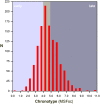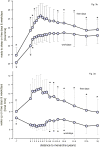Consequences of the timing of menarche on female adolescent sleep phase preference
- PMID: 19384418
- PMCID: PMC2668189
- DOI: 10.1371/journal.pone.0005217
Consequences of the timing of menarche on female adolescent sleep phase preference
Abstract
Most parents experience their children's puberty as a dramatic change in family life. This is not surprising considering the dynamics of physical and psychosocial maturation which occur during adolescence. A reasonable question, particularly from the parents' perspective, is: when does this vibrant episode end and adulthood finally start? The aim of the present study was to assess the relationship between puberty and the changes in sleep phase preferences during female maturation and adulthood by a cross-sectional survey. The results from 1'187 females aged 5 to 51 years based on self-report measures of sleep preferences on weekdays and on free days as well as the occurrence of menarche, show that in contrast to prepubertal children, adolescent females exhibit a striking progression in delaying their sleep phase preference until 5 years after menarche. Thereafter, the sleep phase preference switches to advancing. The current study provides evidence that a clear shift in sleep-wake cycles temporally linked to menarche heralds the beginning of "adult-like" sleep-wake behaviour in women and can be used as a (chrono)biological marker for the onset of adulthood.
Conflict of interest statement
Figures






References
-
- Czeisler CA, Khalsa SBS. The human circadian timing system and sleep-wake regulation. Principles and Practice in Sleep Medicine. 3 ed. Philadelphia: W B Saunder; 2000. pp. 353–375.
-
- Duffy JF, Czeisler CA. Age-related change in the relationship between circadian period, circadian phase, and diurnal preference in humans. Neurosci Lett. 2002;318:117–120. - PubMed
-
- Mongrain V, Lavoie S, Selmaoui B, Paquet J, Dumont M. Phase relationships between sleep - wake cycle and underlying circadian rhythms in Morningness - Eveningness. J Biol Rhythms. 2004;19:248–257. - PubMed
Publication types
MeSH terms
LinkOut - more resources
Full Text Sources

